ACCIDENT: Branson, Duck & Cover?📌
VamoSetbacks: Incidents & Accidents (Premise).
The NTSB released a 14-page report November 14, 2019 on the July, 2018 Branson accident, ![]() officially declaring that the Coast Guard has been ducking implementation of nearly half of the safety board’s requirements for these amphibious craft. Among those 1999 recommendations were: more sealed spaces above the waterline for ‘reserve buoyancy’, and the removal of onboard hazards such as overhead canopies than can obstruct evacuations. The latter would include ill-designed seats, windows, windshields and deck rails—more rigorous standards that ‘Stretch Duck 7’ failed to fully meet. The Missouri accident remains one of the worst touring vessel incidents in U.S. history.
officially declaring that the Coast Guard has been ducking implementation of nearly half of the safety board’s requirements for these amphibious craft. Among those 1999 recommendations were: more sealed spaces above the waterline for ‘reserve buoyancy’, and the removal of onboard hazards such as overhead canopies than can obstruct evacuations. The latter would include ill-designed seats, windows, windshields and deck rails—more rigorous standards that ‘Stretch Duck 7’ failed to fully meet. The Missouri accident remains one of the worst touring vessel incidents in U.S. history.
As deeply tragic and troublesome as was the Branson duck boat sinking, in one respect it barely skims the surface: That is, the overall safety of these sightseeing operations.
To recount, an amphibious boat launched in calm Ozark waters with a load of happy heartland tourists. Suddenly a powerful thunderstorm system rolled over southern Missouri, roiling Table Rock Lake with near 70 m.p.h. winds. And the sitting duck tour craft capsized, plunging 40 to 80 feet to the lake bottom. 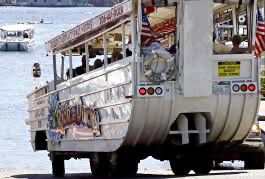
Of the 29 passengers, two crew members aboard, 17 (ages 1 to 70) perished by drowning, once the two-way vehicle began taking on water in crashing four-to-six foot swells. Here a roughly 20-minute summertime vacation pleasure cruise turned to screams, cries, and hollering, debris flying every whichaway.
Beyond the question of why only one of the two craft plying Table Rock Lake at the time made it back safely to shore; why the boat captain survived, but not the driver nor nine members of a single Indiana family, comes the question: How does an isolated sightseeing boat mishap in a country & western tourist trap jibe with the Vamigré way?
Duck Blind.
First some further particulars: According to the NTSB, turns out the doomed duck-style craft left its Branson terminal shortly after 6:30 pm and arrived at Table Rock Lake just before 7 pm, its crew directed to take the water part of its tour first, due to potential changing weather conditions (but later was found to have also resulted from Ride the Duck Branson’s desire to avoid refunding pre-paid fares). Before launch, Ride the Ducks’ captain pointed out emergency exits and demonstrated life jackets usage (though noting they likely wouldn’t be needed), the boat entering calm waters at 6:55 pm. Just relax and enjoy this unique adventure, passengers were told, children quacking away on the yellow duck whistles they were supplied.
Yet the National Weather Service in Springfield, Missouri had issued a severe thunderstorm alert as early as midday that Thursday, July 19—then an actual warning for southern Missouri at 6:32 pm, nearly 40 minutes before the duck boat entered Table Rock Lake. Whitecaps began appearing there just after 7 pm, strong winds whipping up the lake with hurricane force swells. The tour captain announced the developing storm conditions to passengers while his (land leg) driver lowered the duck’s plastic side curtains by 7:01 pm, its bilge alarm activating at 7:04, inexplicably stopping a minute later.
The duck boat began taking on water at approximately 7:07 pm, as that alarm activated again. But it went under shortly after 7:08, hastening one of the worst U.S. maritime disasters in decades.
Ducking Out of the Storm…
It has yet to be clarified why the craft entered Table Rock Lake under such circumstances. Ride the Ducks Branson, owned by Ripley Entertainment, said this was the first accident of this sort at RtheDs in its 40 years of operation, but was unclear on the company’s threshold for aborting a tour. Although weather service meteorologists in Springfield insisted that “when we issue a (storm) warning, it means take action.”
Which shifts focus to the duck boats themselves. The name derives from their original mission: military DUKW (acronym from military equipment coding) vehicles designed to both float on water and 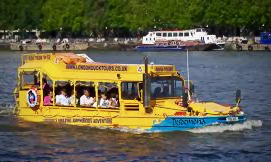 drive over dry terrain. These early models transported ship-supplied materials and troops ashore at Normandy, as well as armaments in the Pacific Theater during WWII.
drive over dry terrain. These early models transported ship-supplied materials and troops ashore at Normandy, as well as armaments in the Pacific Theater during WWII.
After all the war victory parades, the military ducks were ‘decommissioned’ to stateside civilian assignments coast to coast, mainly via military surplus sales. The craft went largely from moving troops and materiél to giddy post-war tourists. Their first operation is said to have been the Wisconsin Dells Ducks, which today has the largest fleet of nearly 100.
From there, the amphibious plump flocked to over 30 cities worldwide, mainly with lakes and/or rivers nearby. A quackin’ good time ride to be had by the droves, who were in the thrall of the ducks’ quirky weirdness—to Boston (1994) and Philadelphia (2003), then onto Austin and Seattle. Ride the Ducks Branson (now based in Georgia) actually began its franchise operation in 1977.
…Into Duck Soup.
Joy rides all right, but not without a web of mishaps afoot, resulting in millions of dollars in lawsuit settlements over the years:
- As early as 1999, a surplus DUKW sank in choppy Lake Hamilton. In minutes, the Miss Majestic went under, 13 of 20 passengers drowning; none were wearing life jackets in the Hot Springs, Arkansas accident.
- A custom Lady Duck sank in the Ottawa River (Ontario, Canada), four trapped and drowning under its heavy canopy in 2002.
- Three accidents in 2010 alone: Two passengers were killed in Philadelphia, when a duck, disabled by an engine fire, was rammed by a tugboat on the Delaware River. A Ride the Ducks boat rear-ended a Seattle passenger vehicle (Duck driver couldn’t see the car). Then a Yellow DuckMarine crashed in Liverpool, UK.
- One year later, a Seattle motorcyclist was crushed when a duck boat ran him over. Another Seattle duck rear-ended a car, as the height of the craft made seeing the auto ‘virtually impossible’.
- A rash of 2013 UK incidents ranged from Yellow Duck sinking (one craft deemed unseaworthy), to another catching fire on the Thames River.
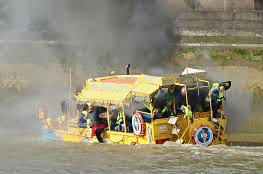
- A 68 year-old woman was struck crossing a Chinatown street in Philadelphia, as the bow of the duck boat made seeing her ‘difficult’ in 2015. A Seattle pedestrian was similarly hit; then five Seattle passengers died, 16 were seriously injured when a boat broke an axle and collided with a busload of students on a narrow Aurora, Washington bridge (one of over 400 safety violations by the independent operator).
- Two more Seattle vehicles were duck struck in 2016 by drivers who ‘couldn’t see them directly in front of him’. A Boston woman died the same year when her moped was nailed by a Boston Duck Tours boat that was turning onto Beacon Street.
What the Duck?
“Duck boats are death traps.” That was the verdict of an attorney who handled litigation on the two Philadelphia accidents. “They’re not fit for water or land because they are half car and half boat.” Other critics are not quite so damning, but do suggest that duck boats present peculiar design flaws.
Primarily, the crafts’ high profile creates built-in blindspots for their drivers on land—especially blocking 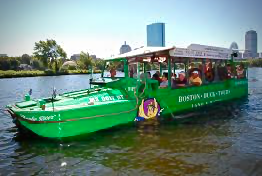 clear visibility of vehicles and pedestrians directly before them. Plus the ducks’ overall span is wider than most city traffic lanes, rendering them less safe navigating urban and village/resort streets.
clear visibility of vehicles and pedestrians directly before them. Plus the ducks’ overall span is wider than most city traffic lanes, rendering them less safe navigating urban and village/resort streets.
On the water, these amphibious craft are said to often lack adequate buoyancy, not least when the boats take on water. With engines below their water line, flooded CBOX pumps can breakdown, and the engines themselves are known to emit carbon monoxide directly into the passenger cabins under such damp or sodden conditions.
Moreover, a duck boat’s heavy canvas canopy and plastic side windows have been found to actually entangle and/or trap passengers in dire situations by obstructing safe exit from the stricken, if not sinking craft.
Ducks Limited?
Little wonder municipal permits and soaring insurance rates can be problematic for duck boat operators. But perhaps more troubling is the reality that there are so few solid regulations on these amphibious hybrids.
Oversight of this tiny, tight-knit duck boat industry is hampered by a division of jurisdiction between the NTSB and Coast Guard, as well as various local state and city governments. So issues of boat maintenance, reserve buoyancy, flotation devices, bilge pumps/alarms, onboard video and mandatory life jackets, to name a few, go unresolved before the fact, not after. That is, even if duck boat operators sufficiently comply with warnings that are handed down—absent thorough official follow-up inspections. Then there are the 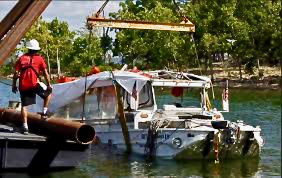 questions as to how captain/driver onboard rider entertainment functions can distract crews from safe operation.
questions as to how captain/driver onboard rider entertainment functions can distract crews from safe operation.
So NTSB investigators found no Table Rock Lake victims to be wearing life jackets, with some caught up in the heavy canvas cover. Thus the Missouri State Highway Patrol has launched a criminal investigation into the fatal accident.
Ride the Duck Branson’s operation has since been closed down indefinitely, and the company has pledged to do all it can to aid/support survivor families. As update, the DB operator has just been indicted for gross negligence…mtc...
Whither the Congestion of Contraptions…
Emblematic case in point: Table Rock Lake may not have been the S.S. Eastland or Andrea Doria disasters, but is tragic just the same. It was a mishap symptomatic of broader, more pervasive travel v. tourism afflictions. Namely, duck boats are one thing, but what about all the other tourist ‘trap-easy’s’ now overwhelming crowded popular-to-magnet destinations, and the manifold quack quacks running these various outfits?
Take, for instance, the smoky behemoth diesel tour buses, Gray Line to grave line, that clog and cloud popular tourist spots; or the sheared roof on/off monsters that are little more than land barges. The belching red double-deckers that have already fouled London air, and are now doing so all over the U.S. Or stripped-out party buses run by who-knows-who that are rocking along city and college town streets with booze and boom boxes flowing freely, minus proper permits or other oversight.
Otherwise, travelers grapple with a swarm of motorized trolleys, pop-top van conversions, derailed tour 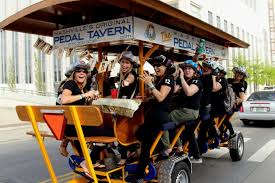 trains, rattletrap jitneys, e-shuttles, recycled horseless buggies, pedal surreys, lawnmower loud GoCars, motored rickshaws and electro-trikes seemingly wherever, whenever we hit upon a well-trodden, garden-variety site, amusement park, fun ride or landmark—Disneyland/World to Dollywood, Great America to the Grand Canyon.
trains, rattletrap jitneys, e-shuttles, recycled horseless buggies, pedal surreys, lawnmower loud GoCars, motored rickshaws and electro-trikes seemingly wherever, whenever we hit upon a well-trodden, garden-variety site, amusement park, fun ride or landmark—Disneyland/World to Dollywood, Great America to the Grand Canyon.
Yet another raison d’être for Destination Diversion. But short of that, if travelers must go to known, overgrown zones, suffer through such contrived plaxic, fauxperiences, better that we discern between large chain and littler local operators. Divine their fees/charges, safety records, insurance coverage and resources overall. Ferret out safely worthwhile conveyances from the rickey jamble of contrived contraptions and untold rig jobs, the worthy or not.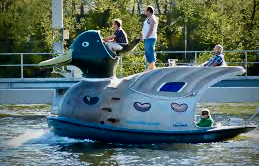
We needn’t stamp them out, just sort them out. Which Vamigré will be doing as we go along, beginning with all those quirky ducks on the ponds…
